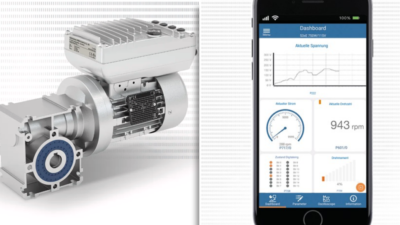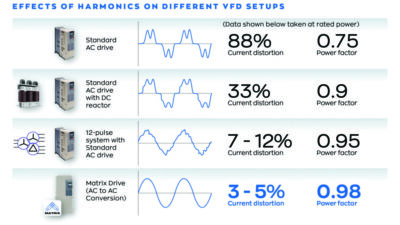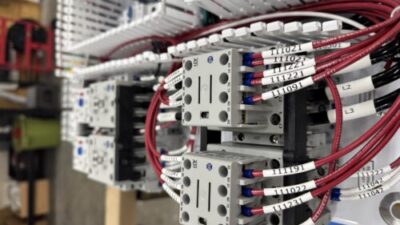P robably the most versatile among motor control methods, ac variable-speed drives (VSDs) are available in three principal flavors. Open-loop control, sensorless vector control, and flux vector control provide increasingly sophisticated command of induction motors [and permanent magnet synchronous motors].
Comparative VSD Characteristics
V/Hz Control
Sensorless Vector Control
Flux Vector Control*
Speed regulation
1%
0.5%
0.001%
Speed range
40:1
100-120:1
>1,000:1
Torque regulation
–
+/-5%*
+/-2%
Starting torque
150%
150-250%**
150-400%**
*Field-oriented FVC base Source: Control Engineering with data from Danfoss, GE Toshiba, Rockwell Automation, and Schneider Electric
Open-loop ac drives employ the simplest motor control, the so-called Volts per Hertz (V/Hz) method. Also known as “scalar” control to differentiate it from vector control methods, V/Hz runs in open loop without a formal feedback device. However, current and voltage sensing is done for current limit and slip estimation. This lower-cost method is basically a speed control, providing relatively low speed and torque response. It offers no torque control or high torque values at low speeds.
Still, V/Hz enjoys the highest percentage of ac drive types in use. A June 2001 Control Engineering /Cahners Research study reported 89% of respondents using this ac drive type (vs. sensorless vector at 41% and closed-loop vector control at 33%). V/Hz control is especially popular for powering pumps, fans, and other continuous process applications. One notable advantage is its ability to easily control several motors from one drive. Various V/Hz patterns are possible in addition to a straight proportional relationship.
Vector variety
At the other end of the VSD spectrum is flux-vector control (FVC). However, FVC has several variations. Its most capable embodiment, field-oriented FVC , models characteristics of the dc motor, through independent control of flux-producing (magnetizing) and torque-producing current components to derive optimal control of motor torque and power. Some drive manufacturers treat field-orientation as a separate FVC technology.
In this “full” FVC method, an actual feedback device (most often an encoder) is used for motor position and speed information. Also the most sophisticated motor models are used in the control algorithms. FVC allows true torque-mode operation and employs separate speed and torque loops. An adaptive controller adds higher dynamic torque regulation. It can account for motor temperature changes and other control disturbances and still deliver optimal torque output. Full FVC delivers high torque at low speeds (even near 0 rpm), and offers very linear parameters over the whole speed range.
Other “vector” drives also treat flux and torque currents as a vector sum of total motor current to improve on speed control and torque output. But, these drive products are derived from a V/Hz base and do not deliver field-oriented FVC performance.
‘Sensorless’ drives add value
Further Reading
For more on ac drive types, see:
CE June 2001, pp. 49-56 (general);
March 2001, pp. 67-75, Sept. `96, pp. 75-82 (SVC drives); and
Feb. `99, pp. 92-98, Feb. `95, pp. 75-81 (FVC drives).
Sensorless vector control (SVC)-a better descriptor used by some suppliers is “encoderless” or open-loop vector control-provides another alternative for improving low-speed torque, speed regulation and starting torque over V/Hz drives. The enhancements come at relatively small additional cost.
Without a feedback device, SVC uses current and voltage signals from the motor to estimate torque and magnetizing current components, as well as the vector relationship between them. However, motor parameter estimates become very inaccurate under 3 Hz (around 90 rpm for 1,800-rpm base-speed machines).
Sensorless drives likewise vary in capability and performance, depending on their derivation from either a V/Hz or vector control base. These drives infer rather than sense motor shaft information so they rely on an accurate motor model. Yet, even with the latest modeling and adaptation methods they can’t match closed-loop performance. Most variable-speed drives offer both sensorless vector and V/Hz operation via software selection; some VSDs offer all three types of control.
Direct control of torque is another sensorless method capable of independent control of an induction motor’s magnetic field (flux) and torque using only voltage and current information from the motor. It eliminates the need for a modulator found in PWM drives. The method depends on a very accurate motor model and a processor that can compare instantaneous torque and flux with reference values as fast every 25
Most ac drives are low-voltage units operating at up to 600 V. Medium-voltage versions (2.3-15 kV) are also available for more efficient current transmission in power cables and motor windings.
-Frank J. Bartos, executive editor [email protected]
Comments? E-mail Frank J. Bartos at [email protected] [email protected]



